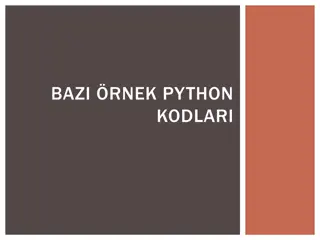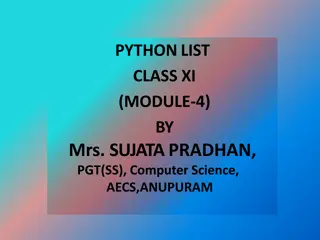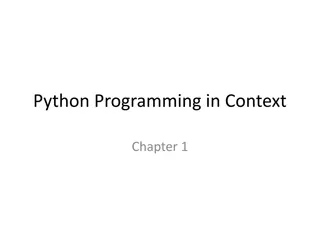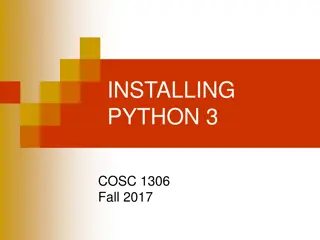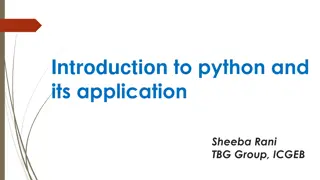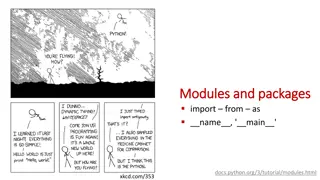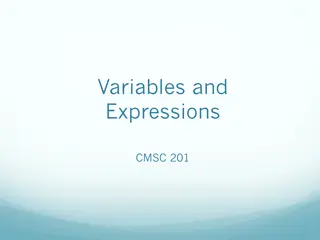
Introduction to Python Lists: Concepts and Examples
Explore the fundamentals of Python lists, including their structure, methods, and usage. Learn how to work with different data types within lists, iterate through elements, and handle user input effectively. Dive into practical examples to solidify your understanding of working with lists in Python.
Download Presentation

Please find below an Image/Link to download the presentation.
The content on the website is provided AS IS for your information and personal use only. It may not be sold, licensed, or shared on other websites without obtaining consent from the author. If you encounter any issues during the download, it is possible that the publisher has removed the file from their server.
You are allowed to download the files provided on this website for personal or commercial use, subject to the condition that they are used lawfully. All files are the property of their respective owners.
The content on the website is provided AS IS for your information and personal use only. It may not be sold, licensed, or shared on other websites without obtaining consent from the author.
E N D
Presentation Transcript
List 1
Objectives O This chapter introduces: 1. The one-dimensional list The two-dimensional list Methods of the list 2. 3. 2
list O In Python: O A list is an ordered collection of objects O In the list: O The length of a list is changeable O Use index values to display the data O Use the [] symbol to create a list O Each element of the list is separated by a comma O List can store multiple data types, such as strings, integers, floating-point numbers, and etc 3
list O E.g: # Declare a list # Storing string, integer and floating point number array=["Hello",123,10.5] list array[0] array[1] array[2] representation index value 0 1 2 data Hello 123 10.5 4
list O Result: O E.g: array=["123",1423,1523.0] # Declare a list #count=(0~<3) =>> 0,1,2 #Print the data ofthe list #method 1 for count in range(0,3): print(array[count]) print() # Print the data ofthe list #method 2 for elm in array: print(elm) print() # Print the whole data of the list in a string #method 3 print(array,"\n") # Display the type of each item in the list for count in range(0,3): print("array[",count,"} Type in:",type(array[count])) 5
list O When input is a string O E.g: O Result: array =[]#Declare a list for counter in range(0,2): #Execute twice #Enter a string guess=input("Enter data: ") # Append the input data to the end of the list array.append(guess) for counter in range(0,2): print(array[counter]) 6
list O When input is a number O E.g: array=[]#Declare a list for counter in range(0,2): #Execute twice #Enter a number #Convert the string to a number guess=int((input(" Enter data :"))) # Append the number to the end of the list array.append(guess) for counter in range(0,2): print(array[counter]) O Result: O Result: 7
list O The following example combines the use of if ... else ..., for loop, and while loop O Select 1, you can enter 2 numbers and save them in the list O Select 2, you can enter 2 string and save them in the list. O After executing twice, the type of the data and the data in the list will be displayed 8
list O E.g: #If you enter 2, add two strings elif(check==2): count=count+1 for counter in range(0,2): #Input string str=(input(" Type in data ")) s.append(str) #Display data in list for counter in range(0,count*2): print(s[counter]) #Display the data type in list for counter in range(0,count*2): print(type(s[counter])) s=[]#Declare a list count=0#counter #Exit the loop after count == 2 while(count!=2): check=int((input(" Enter 1 to add two numbers\ \nEnter 2 to add two strings "))) #If you enter 1, add two numbers if(check==1): count=count+1 for counter in range(0,2): #Convert string to number num=int((input(" Type in data "))) s.append(num) 9
list O Result: 10
list O The dimensional list O A two-dimensional different types of data following table describes a two- list can also store array[2][3] 0 1 2 0 array[0][0] array[0][1] array[0][2] 1 array[1][0] array[1][1] array[1][2] 11
list O E.g: array= [[1, 2, 3], [4, 5, 6]]# two-dimensional list for counter1 in range(0,2):#list has 2 rows for counter2 in range(0,3):#list has 3 columns print(array[counter1][counter2],end = ' ') print("\n") O Result: 12
list O Most commonly used methods of list: O append(), extend(), insert(), pop(), remove(), reverse(), sort().... 13
list O E.g: O Result: # Declare a list array = [1,2,3,"HELLO","KUAS"] print(array) #Insert an integer data at the end of the list array.append(123) print(array) #Insert the character y at position 2 of the list array.insert(2, "y") print(array) #Append the elements ['a','b'] to the current list array.extend(['a', 'b']) print(array) 14
list O E.g: # Declare a list array = [1,2,3, "HELLO", "KUAS"] # Display the last element and removes it from the list print (array.pop ()) # Display the remaining data in the list print (array) # Remove the element '1' from the list array.remove (1) # Display the remaining data in the list print (array) O Result: 15
list O E.g: #Declare a list array = [1,8,2,5,3] # Sort the element in the list in an increasing order array.sort() print(array) # Use the "reverse" statement to reverse the data in a list array.reverse() print(array) O Result: 16
Sources O References: O http://openhome.cc/Gossip/Python/IOABC.h tml O http://www.pythondoc.com/pythontutorial3/i ntroduction.htmlhttp://blog.eddie.com.tw/20 11/10/13/python-list/ O http://openhome.cc/Gossip/Python/listType. html O Python 17
Exercise 1 O Design a program that will repeatedly ask the user to select 1, 2, 3, or 4, until -1 is selected. O Select 1, execute append() to insert data into the list, O Select 2, execute pop() to delete the last data of the list, O Select 3, execute insert() to insert data in a specified list position, O Select 4, execute remove() to remove the specified data,
Exercise 2 O Input: 1 1 3 1 2 4 1 2 -1 O Result:
Exercise 3 Design a program that will ask the user to input a string and show if the string is palindrome or not, where palindrome is a string that can be backwards while only showing itself. O Input Madam Anna mannan false written forwards or Output : True True
Exercise 4 O Write a program and print the value of Q according to the given formula: Q = ([(2 * C * D) / H]) (in words: Q equals the square root of [(2 times C times D) divided by H]), where C (= 50) and H (= 30) are constants, and D is inputted from the user. Note that multiple values of D are separated by commas. O Input : 100,150,180 O Output : 18,22,24 O Suggestions: O If the generated output has a decimal value, you need to round it to the nearest integer, for example 26.0 will be printed as 26.
Exercise 5 O Write a Python program that accepts a hyphen-separated sequence of words as input and prints the words in a hyphen- separated sequence after sorting them alphabetically. O Input: green-red-yellow-black-white O Output: black-green-red-white-yellow 22
Exercise 6 O Write a program that can read data, including student s name and his five subject scores, from data.txt. Please output students data that are sorted in decreasing order of the average of the five subject scores. Result: 23





